
Measuring the business value of corporate social impact Beyond social value to enterprise performance
18 minute read
31 July 2020
How much is corporate social impact worth? Today, improved measurement techniques and data analytics can enable companies to better understand the business value of their social impact efforts, enabling them to better allocate resources and make strategic decisions.
In the midst of the COVID-19 pandemic, businesses are stepping up with massive contributions in the name of public health and well-being. For most of these companies, responding to the current crisis is simply a moral imperative. But once the next normal is reached on the other end of the crisis, many companies will once again be forced to articulate the business value of corporate social impact.
Learn more
Explore the Social impact collection
This article is featured in Deloitte Review, issue 27
Create a custom PDF or download the issue
Learn about Deloitte’s services
Go straight to smart. Get the Deloitte Insights app
More and more leaders are beginning to recognize that value. Deloitte Consulting LLP’s 2019 Global Human Capital Trends survey found that, for the first time ever, CEOs named societal impact as the top success factor for annual performance.1 As Larry Fink argued in his 2020 letter to CEOs, “A strong sense of purpose and a commitment to stakeholders helps a company connect more deeply to its customers and adjust to the changing demands of society. Ultimately, purpose is the engine of long-term profitability.”2
However, many corporate leaders have struggled with how to adequately assess the business value that social impact efforts provide. Social impact activities are typically presented in terms of their “social value” only— the public good they do in the world. This can make it difficult for leadership to effectively weigh corporate social initiatives against other business needs and to properly understand the relative importance of social value to the company’s overall economic value.
Fortunately, measurement techniques and data analytics have improved in ways that now enable organizations to measure the business value of social impact as well. This can be done by organizing measurements along six key drivers of value creation from corporate social activity—brand differentiation, talent attraction and retention, innovation, operational efficiency, risk mitigation, and capital access and market valuation3—and then adapting existing business metrics to measure the business value of these benefits in ways that are comparable and consistent with other corporate considerations. This, in turn, allows a company to more accurately assess risks, assign costs, and predict growth related to social impact activities.
Using this approach, corporations can identify concrete measures around both the social and business value of each of the six dimensions. These measures together can be used as a form of corporate social impact scorecard that can help business leaders make key decisions about when and how to integrate social purpose into core business activities across the business or with specific campaigns, initiatives, or brands.
Six drivers of business value from social impact
The term “social impact” is used expansively to cover philanthropic and volunteering initiatives, sustainability efforts to mitigate social and environmental risk, and other core business activities that also deliver economic, social, and environmental benefits.
In 2016, Monitor Deloitte identified six primary areas where a company’s social impact efforts can drive business value:
- Brand differentiation. Social purpose has been shown to drive consumer purchasing decisions and enable companies to charge a price premium, leading to increased revenue.
- Talent attraction and retention. Alignment between company and employee values increases employee engagement, leading to improved profitability through higher productivity and cost reductions from lower turnover.
- Innovation. Efforts to improve the healthiness and/or environmental and social footprint of products can be an engine of innovation, spurring increased revenue from new products and new markets.
- Operational efficiency. Decreasing a company’s footprint in packaging, water use, materials use, and waste production can yield significant cost savings.
- Risk mitigation. Failure to effectively address environmental and social risks can create serious financial and operational performance challenges. Social impact efforts can have important mitigation effects, resulting in avoided costs or lost revenues and higher valuations.
- Capital access and market valuation. Corporate social impact efforts are positively related to market valuation and cost of capital.4
A company can break out and specifically measure the business value derived from each of these areas to create a corporate social impact scorecard that can look across all six areas or focus on just one or two priority areas, depending on a company’s industry, business priorities, and scope of efforts. Using the scorecard, social impact professionals and business leaders can not only better understand the value of their current social impact activities, but also prospectively calculate social impact investments’ potential net benefits to better allocate resources and make strategic decisions to benefit the company’s long-term health.
Principles for creating a social impact scorecard
The process of developing a corporate social impact scorecard is meant to be flexible, allowing it to provide the necessary insight for decision-making under a variety of circumstances and to adapt to diverse corporate environments. The scorecard can be used to value individual social impact initiatives, assess the effects of broad purpose efforts on specific business units or functions, or provide an aggregate view of the business value of social impact activities across the company. Business leaders can create comprehensive scorecards or target very narrow business questions. It is important to create a fit-for-purpose approach that leads to actionable information and uses reasonable resources in data collection and analysis.
Key principles behind creating such a scorecard are:
- Determine the key decision(s) to be made that involve the business value of social impact. For example, are you aiming to decide whether to invest in socially responsible new product development, assess the social and environmental practices of your supply chain, or determine whether the company is receiving sufficient returns for all of its social impact work? Being clear about the questions you are trying to answer and for what purpose helps define the scorecard’s scope and clarify the types of relevant goals or targets it should consider.
- Assess which drivers of business value are salient. While some business questions are specific to particular business functions or units, others have wider applicability and may touch more than one of the six dimensions of social impact’s value. Moreover, all six dimensions may be relevant in the case of cross-company scorecards. The business drivers behind the specific social impact activities to be considered in the scorecard will govern what and how costs and benefits are measured.
- Determine how business activities and outcomes are already measured internally absent social impact considerations. Wherever possible, it is important to align with existing business measurement systems and approaches to enable comparability and actionable information. Internal measurement systems and approaches for determining risk, for example, can be adapted to include environmental and social risks, as can employee engagement and brand reputation approaches. While adjustments are necessary and distinct techniques may be used, alignment with existing approaches is essential to enable business decision-making around social impact.
- Choose appropriate indicators to capture the business value of social impact—indicators that can quantify the costs and benefits of initiatives or effects to track. In addition to maintaining internal comparability, use indicators that are consistent with standard social impact approaches to facilitate peer benchmarking where possible. Methods and resources are discussed below.
- Monetize where relevant. It is often helpful to translate net benefits into monetary values for the purpose of assessing business value. Monetization is particularly helpful for evaluating relative benefits across a range of drivers, as well as for making resource and investment decisions. However, it should be noted that for some business questions translating benefits to monetary values may be difficult and unnecessary. Efforts to monetize value should be driven by what’s needed for decision-making.
With these principles in mind, let’s explore what it looks like to measure each of the different dimensions on a corporate social impact scorecard in turn.
Brand differentiation
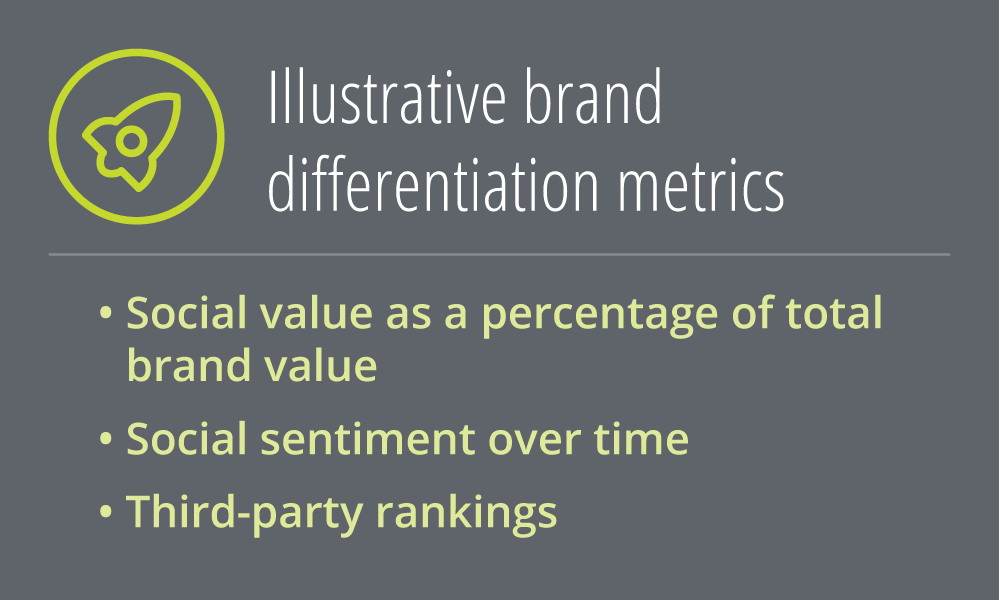
Social impact and corporate purpose drive business value by enhancing consumer identification with brands as an expression of their values, which can affect consumers’ purchase choices, their loyalty, and the costs they are willing to incur.
The importance of social impact to brand reputation is considerable. The RepTrak Company has found that good “citizenship” and good “governance” qualities account for nearly 30 percent of corporate reputation, more than any other factors besides products and services.5 Nielsen has found that two out of three consumers are willing to pay more for sustainable brands,6 and recent retail research shows that, after quality, the second-highest reason for customer brand loyalty is sustainable/ethical business practices.7
To assess the brand value of social impact, consumer purchase and use decisions can be broken down to understand the weight of different choice elements, including those related to social impact. Companies whose reputations are large enough to be tracked and indexed can work with various third-party organizations that track reputation to determine the relative importance of social impact, broadly, to a company’s overall reputation. The RepTrak Company, for example, includes citizenship and governance as part of its standard breakdown of consumer perceptions of different components of reputation.8 If an organization has developed a total dollar brand valuation, or if a third-party valuation exists, it can calculate the dollar value of the percentage of reputation attributable to social impact concerns.
While third-party rankings can be helpful for determining the reputational value of social impact for larger companies, smaller companies may need to construct or adapt existing consumer preference data collection tools to disaggregate the social impact component of brand value. Companies could also conduct their own research to explore more fine-grained consumer preference questions. Additional aspects of customer preference can be measured through surveys, focus groups or interviews, social sentiment analysis, and sales data.
Through surveys or interviews, leaders can explore ways to help address new market segments and better target existing customer segments, assess the value of marketing campaigns that spotlight the company’s social impact work, and understand the possible business impact of additional social impact efforts. These tools can allow companies to assess how specific social impact efforts or sustainable product attributes affect purchase intent—whether they make consumers more or less likely to make a purchase. They can also help assess consumers’ price sensitivity for sustainable products as well as their brand loyalty to these products.
To monetize this more granular consumer preference data, business leaders can capture the price premium of sustainable products and services, additional sales revenue through new market segments, and the lifetime value of sustainability-oriented consumers.
A resource for measuring impact on brand differentiation
The RepTrak Company tracks the reputations of 7,000 companies each year. The corporate citizenship component of RepTrak’s measures tracks customer perceptions of whether a company supports good causes, has a positive societal influence, and is environmentally responsible, while the governance component tracks perceptions of a company’s openness and transparency, ethical behavior, and fairness in the way it does business. The RepTrak Company helps quantify the impact of these components on purchasing decisions, as well as consumer willingness to advocate for, accept, and defend a brand.9
Talent attraction and retention
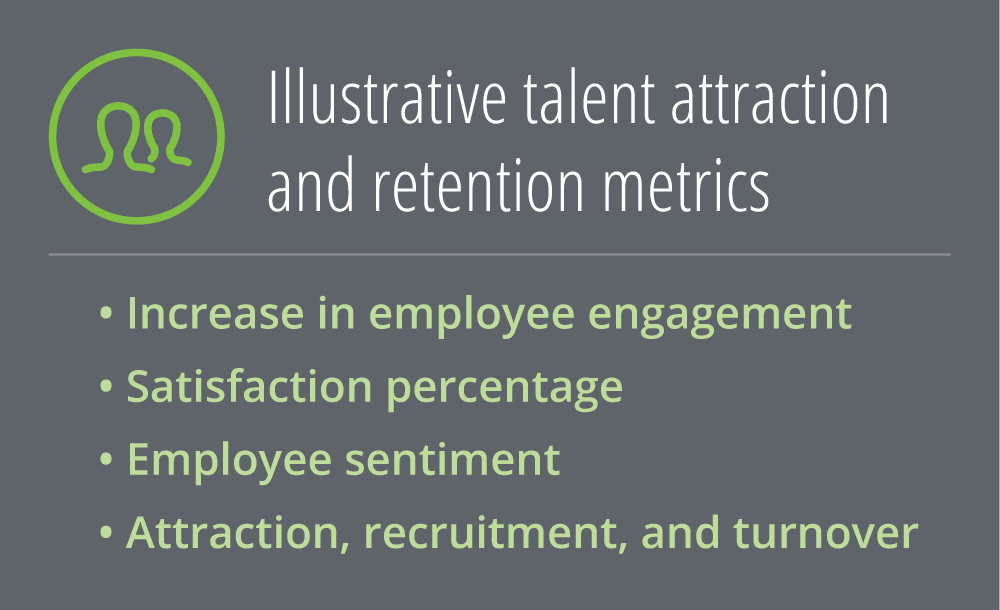
In most industries, talent represents a substantial percentage of company budgets and is a critical driver of profitability. Replacing one employee can cost from one-half to two times the employee’s annual salary due to recruiting, orientation, and training costs.10 On the flip side, high worker engagement delivers measurable benefits to the bottom line: Companies with top-quartile employee engagement ratings have twice the customer satisfaction and 25 percent higher profits than organizations with bottom-quartile engagement ratings.11
Research shows a clear link between employee alignment with company social impact values and higher worker engagement rates, lower turnover, and improvement on other measures of business health. Employees are more likely to stay with companies that offer volunteering and fundraising opportunities.12 Nearly 40 percent of millennials say they selected their job because their employer’s social impact was better than that of alternative companies.13 Gallup has found that a 10 percent increase in employees’ connection with their organization’s mission or purpose would lead to a 13 percent decline in safety incidents, an 8 percent decrease in turnover, and a 4 percent improvement in profitability.14 Social impact efforts can therefore play an important role in talent recruitment, retention, and engagement strategies.
Since talent benefits can come from the direct and indirect effects of volunteering and fundraising initiatives as well as from a company’s broader corporate purpose, leaders will need to collect different types of data on employees based on the specific decisions to be made. To measure the direct effects of social impact volunteerism or social impact involvement, leaders should start with employee participation data. To measure alignment with corporate purpose and the indirect effects of a company’s social impact efforts, which can lead employees to feel more connected to companies that engage in social impact work even if they don’t directly participate in these activities, leaders should track employee awareness of and alignment with corporate social impact efforts.
Employee perceptions about their alignment with a company’s purpose, as well as this alignment’s correlation with satisfaction levels, can be assessed through tailored surveys, frequent pulse checks, and/or other sentiment monitoring based on employee chat logs and comment streams gathered from internal communications tools.15 Employee engagement surveys can be used to assess whether those who participate in social impact activities and those who feel more aligned to corporate purpose experience higher engagement levels.
Business leaders can also correlate employee sick leave, turnover rates, performance, and profitability with social impact participation rates and alignment data for individuals and teams. Return on investment can be calculated using cost valuations for this kind of employee outcome data. It will be important to account for the time lag for metrics such as attrition; the effect of participation in social impact activities may also decay over time.
Innovation
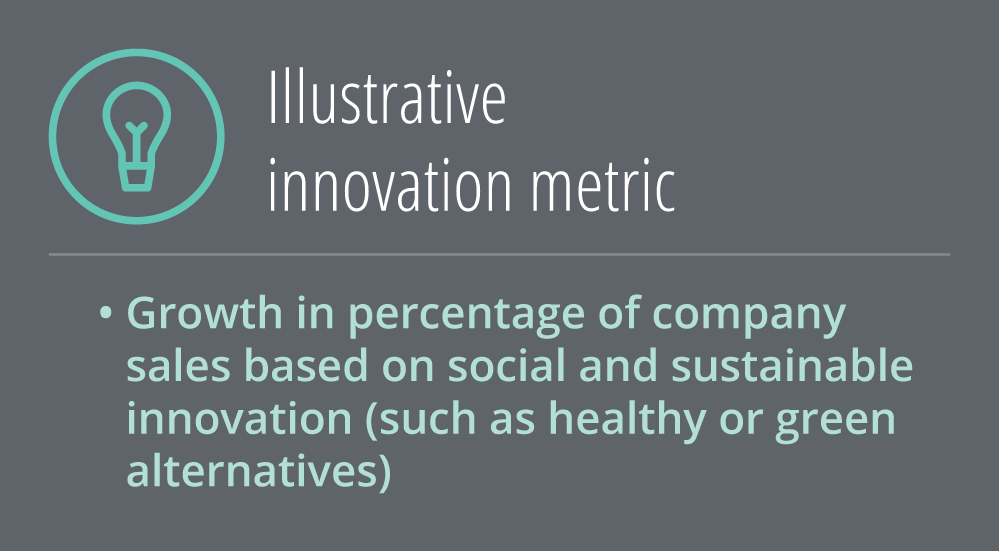
Product innovation is a key driver of long-term company growth, enabling companies to access new markets and users as well as drive more revenue through existing channels due to product improvement. Within the broad category of innovation in general, social innovation involves the development of products or other solutions to address systemic social and environmental challenges, while sustainable innovation involves the development of products and services that improve consumer health or well-being or are socially or environmentally sustainable in their production or use.
Since 2014, US sales of sustainable products have grown by nearly 20 percent, with a CAGR that is four times greater than typical consumer products.16 In a large majority of consumer product goods categories, in fact, sustainable products have been the fastest-growing product segments.17
For purposes of demonstrating the value of sustainable product and services development, the most effective measures adapt existing innovation metrics to explicitly track the percentage of new products or services that have a social innovation or sustainability component. Percentage of sales (or growth in sales) driven by product innovations related to environmental, social, or health factors provides the most direct assessment of the value of social or sustainable innovation. Leaders can also measure the overall growth rates of a company’s new sustainable products, innovation in sustainable products as a percent of overall product innovation, and the growth rates of new customer segments focused on sustainability to determine their growth and speed of adoption.18
Return on innovation investment, which is calculated by dividing the profits generated by new products and services by the research, development, and other direct expenses expended in their creation, can also be a useful metric. This can be calculated for social and sustainable innovation investments by specifically focusing on profits from sustainability-related customer segments or product categories. These figures can then be compared to industry benchmarks, internal thresholds, or other portions of the product portfolio to help assess whether the company is sufficiently including social and sustainable innovation as drivers of product growth.
Operational efficiency
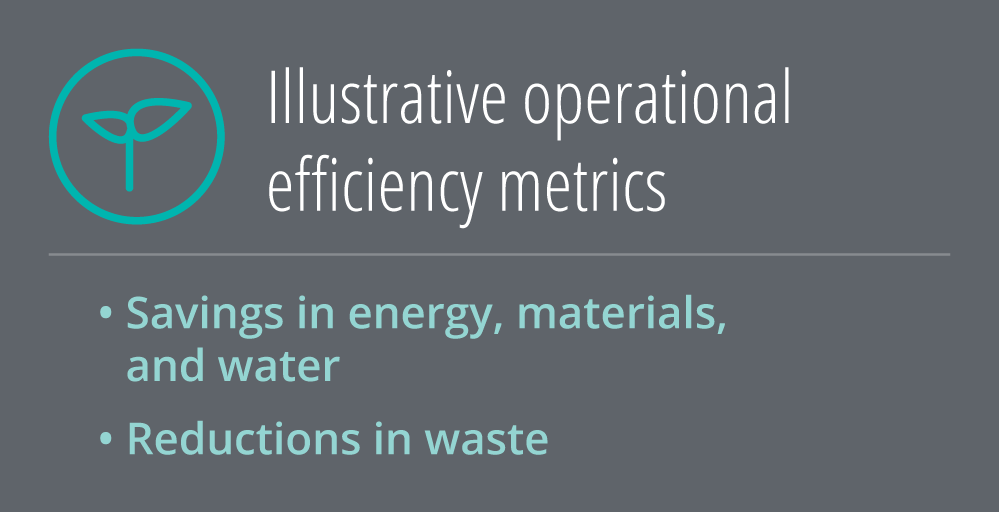
In the context of social impact, operational efficiency enables companies to continue to maintain the quality of their products or services while reducing their environmental and social effects. Operational efficiency is the easiest driver to translate into business value, since it is immediately translatable into cost impacts, and it is often the area where the biggest direct business value can be achieved. One study found that companies could achieve an average internal rate of return ranging from 27 to 80 percent on low-carbon investments alone.19
While social savings such as reductions in worker injury or illness can also be relevant, operational efficiency gains commonly focus on environmental issues such as resource use, waste management, and emissions. Business leaders and social impact professionals can bolster efforts to reduce environmental and social impact by making a clear business case, and business leaders can calculate returns on operational efficiency investments to weigh against competing investment options. Determining where the biggest returns on operational efficiency gains can be made also helps leaders prioritize efforts.
The primary approach for measuring the business value of operational efficiency as a result of social impact is to calculate the net benefits of operational changes from a baseline, factoring in total operational costs avoided and subtracting out total social impact efficiency initiative costs and investments, while taking into account depreciation and amortization for capital expenditures and other investments. Savings from potential decreases in the use of energy, product materials and packaging, and water; costs avoided from the use of recovered materials; and reductions in regulatory fees and fees from waste disposal are common areas of focus. Other potential areas of gain, such as additional revenues from recycled and reused materials and new revenues from additional capacity use, should be considered as well.20
Calculating net returns and the return on investment across multiple possible efficiency initiatives often provides sufficient information for investment and prioritization decisions. Standards such as those developed by the Sustainability Accounting Standards Board (SASB), the Global Reporting Initiative, and the Carbon Disclosure Project offer clear measures and guidance for the capture of relevant operations data. Following these standards has the additional benefit of enabling comparability with other companies’ efforts and industry benchmarks.
A resource for measuring impacts on operational efficiency
SASB provides standards for identifying, managing, and reporting on sustainability topics and related measures that are material for financial and operational performance. These standards describe the minimal set of financially material sustainability topics and related metrics for companies by industry, along with technical protocols for compiling data and activity metrics that enable companies to normalize and compare data.21
Risk mitigation
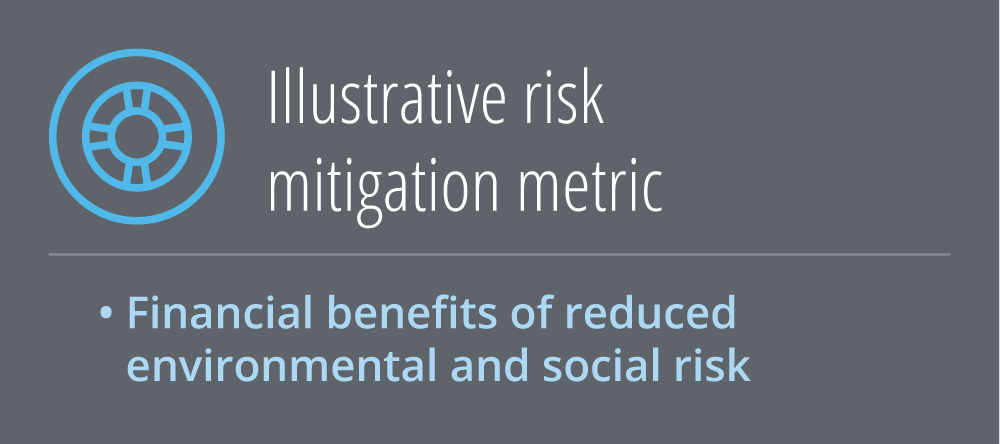
The mitigation of environmental and social risks can have a substantial impact on corporate financial conditions and operating performance. Failure to effectively address environmental and social risks can result in disruptions in operations, market imbalances, negative regulatory outcomes, and damaged reputations with customers, consumers, and employees from negative events. In 2019, 215 of the largest global companies reported almost US$1 trillion at risk from climate impacts alone, with many risk events possibly occurring within five years.22
Absent an accounting of the financial implications of environmental and social risks, companies are likely to undervalue mitigation efforts and take insufficient action to address those risks. Companies may also miss business opportunities that can arise through avoiding, reducing, or sharing risk. Assessing the costs and return of environmental and social risk mitigation enables business leaders to make more complete risk management decisions and prioritize responses. Leaders can also calculate the risk mitigation value of broader social impact efforts to better capture their full range of benefits.
Ideally, business leaders integrate material risks related to environmental and social issues into their enterprise risk management system.23 A variety of materiality assessment tools are available to help companies identify relevant business risks and stakeholder concerns. The SASB’s materiality map, for instance, identifies more than 25 sustainability issues that may affect the financial condition or operating performance of companies by industry,24 and provides a range of additional broad business, stakeholder mapping, and environmental, social, and governance (ESG)-specific materiality resources.25
For each relevant risk, leaders should identify potential interventions, develop key indicators, calculate baseline data and potential risk, and then monetize the risk. Depending on the type of risk, quantitative assessments of risk can be made using methods such as probabilistic analysis, forecasting and valuation for business continuity, expert input, and ESG-specific tools for operations.26
Monetization metrics for key risk indicators can include avoided costs or lost revenues, higher valuations, and avoided opportunity costs;27 multiple valuation techniques can help leaders capture different dimensions of value. For example, a company could use market-based valuation approaches that use existing prices for goods and services to estimate potential losses, while cost-based approaches enable leaders to estimate value from avoiding the costs of compensating affected customers or making repairs to faulty products. Revealed and stated preference approaches allow companies to determine the potential financial impacts of likely stakeholder activities (such as reduced consumption) by observing existing market behavior, or by directly asking stakeholders their preferences. Finally, value transfer techniques estimate economic value by adapting the findings of studies of similar circumstances.28
A resource for measuring social impact risk
The Committee of Sponsoring Organizations of the Treadway Commission (COSO) and the World Business Council for Sustainable Development (WBCSD) have released guidance, Enterprise risk management: Applying enterprise risk management to environmental, social and governance-related risks, that helps companies incorporate ESG-related risks into their ongoing enterprise risk management processes. As part of a comprehensive risk management framework, this guidance includes measurement options for monetization and other quantitative approaches to assessing social impact risk, as well as resources and approaches for determining the nature of those risks.29
Capital access and market valuation
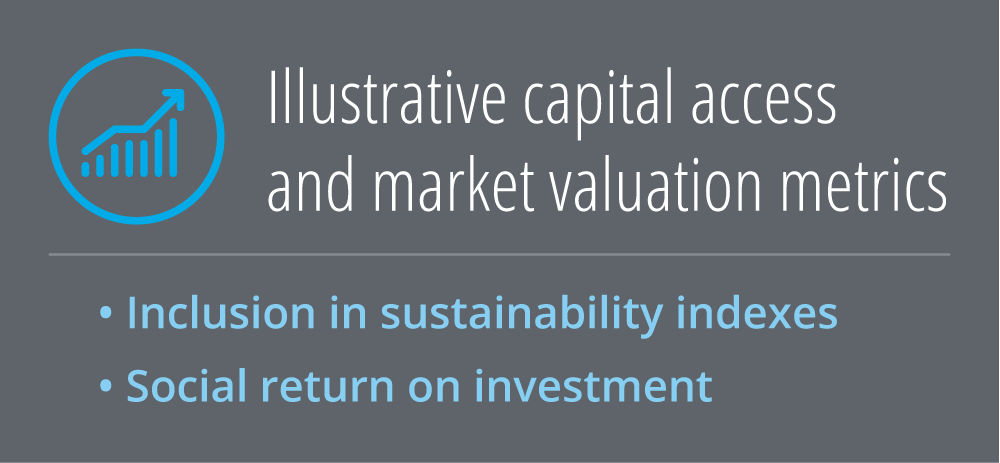
Because market valuation is a function of revenues, costs, and risk, the other five areas of social impact benefit feed into valuation. In 2018, Bank of America Merrill Lynch determined that companies with better social impact records had greater three-year returns and were more likely to become “high-quality” stocks. Their stocks were also less likely to have substantial price drops, and the companies were less likely to experience bankruptcy.30 Recent research also underlines the importance of materiality and operational effectiveness in market performance. Companies that primarily target material social and environmental issues in their social impact efforts outperform the rest of the market to achieve an annual alpha of 3–6 percent.31
Sustainable investing, which broadly refers to investing based on some set of ESG criteria, is increasingly important in capital markets. Sustainable investment assets under management globally reached US$30.7 trillion in 2018, a 34 percent increase in two years.32 In the United States, 26 percent of all professionally managed investment assets included sustainable investing strategies in 2018.33
For purposes of measuring social impact’s benefits to capital access and market valuation, we will focus on both the call for and the demonstrated market benefits of transparency in social impact. Transparent and comparable reporting can enable financial accountability and the more efficient allocation of capital to promote long-term sustainability. It also can lead to higher costs of capital for less sustainable companies.
Reporting on the value of social impact is itself an important component of comprehensive reporting and transparency. To inform sustainability indexes and to serve social impact market strategies, a company’s reporting needs to capture the full range of integrated environmental, social, and economic impact of its social impact activities.34 As a means of capturing value, social return on investment (SROI) is a method for measuring social, environmental, and economic outcomes and calculating monetary values to represent them. This is particularly helpful for leaders when comparing programs that have different types of outcomes, such as education and environmental programs. The SROI calculation process is stakeholder-focused, calculating the financial implications of the meaning and importance that stakeholders assign to social and environmental outcomes. It can also enable future projection, net present value calculations, and sensitivity analyses to determine the impact of changing assumptions.
Resources for measuring impact on capital access and market valuation
The Impact Management Project provides guidance on how to measure, manage, and report social impact. The project brings together the perspectives of investors, funders, businesses, nonprofits, standards bodies, and accounting bodies to create measures with broad applicability across corporate reporting, impact investing, and philanthropy.35
Social Value International has developed principles for assessing social return on investment and social value more broadly for the purpose of better integrating social, environmental, and economic value into decision-making.36
Beyond social impact for its own sake
Social impact can have a substantial effect on business value across each of these drivers, and a lack of understanding of these benefits could result in serious miscalculations and undervaluing of social impact’s business importance. By understanding how to measure the business returns of social impact, leaders can translate social value into the language of business and demonstrate the value of social impact work to make sure that it is appropriately included in strategic and resource allocation decisions. Companies that use these techniques may not only gain a more complete picture of social impact’s business value, but may also find increased incentives over time to expand their social impact efforts and integrate social purpose into their core strategy.
© 2021. See Terms of Use for more information.
Explore the issue
-
Implementing the smart factory Article5 years ago
-
Private 5G networks: Enterprise untethered Article5 years ago
-
The sustainability transformation Article4 years ago
-
Deloitte Review, issue 27 Collection4 years ago















